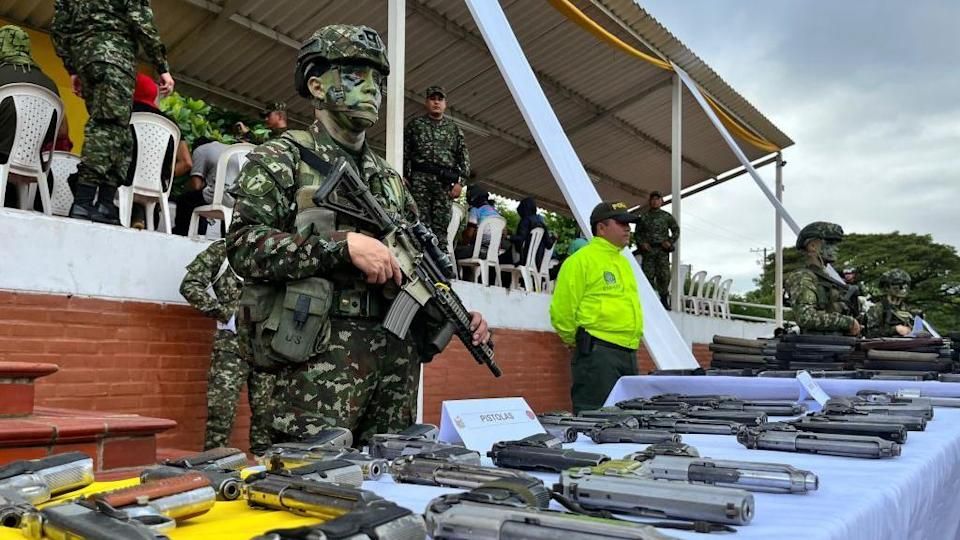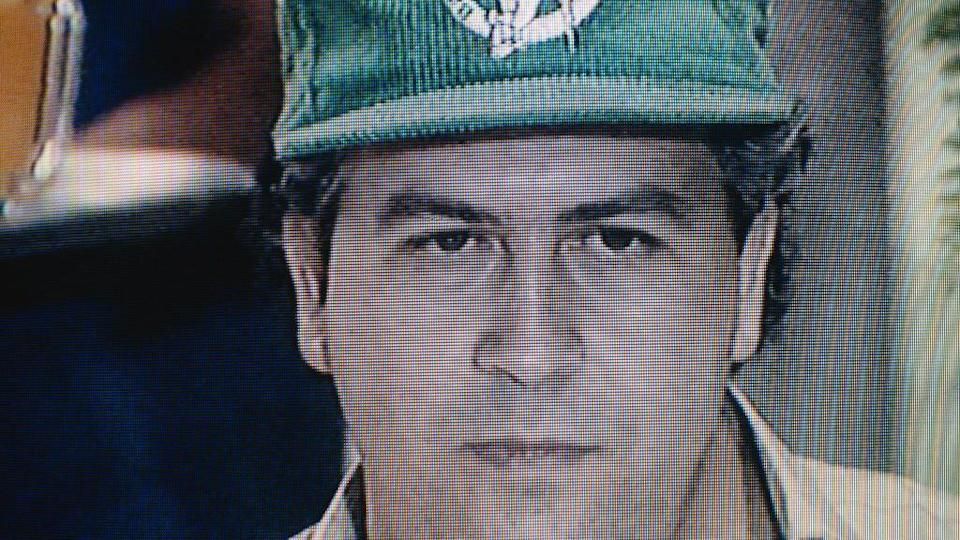The numbers are chilling. According to the president of Colombia, Gustavo Petro, at least 27 uniformed, between police and military, were killed between April 15 and 27 by different armed groups.
The president, as well as experts and analysis centers, explain this regrowth of violence in part to a “gun plan”, a strategy against the public force appealed by armed groups that dates back to the end of the 80s, when Pablo Escobar launched an offensive against the Colombian state that killed hundreds of uniformed.
Colombia, just over a year of new presidential elections, sees how time is exhausted for the ambitious strategy of “total peace” that Petro promised and that throws disappointing results for Colombians.
Only in this 2025, crisis of violence in regions such as Catatumbo, Cauca and Valle del Cauca lit alarms on the deterioration of the security situation in the country, which continues to aggravate with this last deadly onslaught against police and military.
The offensive, according to researchers, is mainly perpetrated by the self -denominated Gaitanista army of Colombia (EGC), better known as the Gulf clan, to which other attacks of dissidents of the FARC and the ELN guerrillas have been added.
“It is not a coordinated plan of these groups, but a coincidental response of them before the turn towards a more confrontational policy by the Petro government,” Laura Bonilla, Deputy Director of the Peace and Reconciliation Foundation in Colombia, tells BBC Mundo BBC.
Rebrote of attacks
At the beginning of April, Colombian media reported how a joint operation between the Colombian Police and the United States Anti -Drug Agency (DEA) ended the life of José Miguel Demoya Hernández, aka “Chirimoya”, pointed out as one of the main leaders of the EGC, which the State considers the largest criminal organization of Colombia and attributes crimes such as drug trafficking and extortion.
According to Bonilla, the last attack against the public force by this group happens in response to this decline.
It is since then that at least 27 uniformed deaths are counted, mostly in attacks allegedly orchestrated by the EGC.
Data from the Ministry of Defense show a more serious situation.
According to this entity, 41 members of the Public Force were killed in service acts between January and March 2025, the worst figure in this same period of time since the first quarter of 2018.
Petro came to power in August 2022. Both campaign and during his mandate promised a different approach to many of his predecessors to achieve peace in Colombia.

He said he would sit at the negotiating table with all possible armed groups, including EGC, heirs of paramilitarism and to which much of Colombian public opinion considers delegitimized to agree on any peace.
Almost three years after his presidential possession, Petro’s strategy results do not meet expectations.
Today the dialogues with the ELN are suspended, the State’s offensive against the EGC and other actors intensifies and recently appointed as Minister of Defense Pedro Sánchez.
This fact was interpreted in Colombia as a confirmation of the turn towards a more combative and hard -handed position of the government against armed groups.
“This causes a change in the expectation of the groups, which now press the State, but not because they have coordinated with each other. To the actions of the Gulf clan, other attacks against members of the public force by other armed, smaller, rural and territorial groups, which are also related to organized crime are joined,” Bonilla reflects.


Pistol VS Plan armed unemployment
Several analysts define the gun plans as strategies of armed groups to selectively murder members of the public force for a period of time.
They ask to differentiate them from the so -called armed strikes, actions in which paramilitaries, guerrillas or criminal organizations attack civil life and armed forces by blocking roads, mobility restrictions, forced closure of commercial establishments and suspension of classes in educational institutions.
The analyst Jorge Mantilla says that the gun plans have been a recurring and recognizable brand of EGC, or Gulf clan, in the last 15 years. And that have happened in response to the capture or elimination of some of their leaders.
“The last antecedent occurred after the extradition of former leader Diro Antonio Úsuga David, alias ‘Otoniel’, in 2022, but the practice dates from the murder of his brother Juan de Dios úsuga David at the hands of Colombian military in 2012,” analyzes this Doctor in Criminology at the University of Illinois in Chicago.


“Since that year, the clan uses armed strikes and gun plans in its moments of greatest confrontation with the State,” adds Mantilla.
During the gun plans it is common for the groups that orchestrate to offer rewards of millions of Colombian pesos (hundreds of dollars) for each policeman killed.
Many of the homicides occur when the uniformed are out of service.
“This wave occurs in the midst of an increase in violence against the public force of dissidents of FARC and ELN, which includes attacks by snipers and ambush and that I would differentiate from the much more municipal and urban logic of Del Clan, inspired by antecedents dating from the time of Pablo Escobar,” says Mantilla.
Inheritance of Pablo Escobar
At the end of the 80s, Escobar launched a raw war against the Colombian State to protect his interests.
Between 1989 and 1992 it is estimated that almost 500 uniformed were killed by salary hitmen of the missing boss of the Medellín cartel.
“In 1989 an Avianca plane broke out in the air, tons of dynamite were triggered in front of the DAS building (Administrative Security Department) to intimidate its director, General Maza Márquez, the presidential candidate Luis Carlos Galán was killed and was paid for killing police officers,” says a report by the Pares Foundation.
“Since then, that idea was latent among several groups linked to drug trafficking with various gun plans organized until today, although without reaching the magnitude it reached in Escobar times,” explains Bonilla.
According to Pares, Escobar used this strategy to reverse the extradition of Colombians to the United States and bend to governments such as Virgilio Barco and César Gaviria.
“In the peripheral neighborhoods of Medellín, Escobar located an office where the hitmen had to take proof that police officers were killed. It could be a plaque, a card and the confirmation of the address where the attack would have been carried out. Up to 5 million pesos were paid by the time by murdered police,” says the report.
“With this background, the clan performs opportunistic attacks in control posts and police dressed in civilians through an intelligence system in which ‘two boys with a motorcycle and a WhatsApp group’ report what happens in each corner,” describes Mantilla.


Special measures and criticism of total peace
Before the wave of murders of assets of the Public Force, the Ministry of Defense recommended some measures such as officials and members of the public force change routines and clothing and carry their weapons at times of rest.
For experts such as Mantilla, the latest events show a collapse of Petro’s total peace policy, which in recent weeks accumulate more and more criticism from several sectors of Colombian society.
One of the toughest wine by former president César Gaviria, who precisely suffered during his mandate the gun plans executed by Escobar.
“The ‘total peace’ is not a state policy. It is an impromptu fantasy, designed without military head, without strategic intelligence, without a realistic road map,” Gaviria said in a letter on May 4.
This Monday, during a Council of Television Ministers, Petro referred to the security situation in the country and said that “there is no chaos of violence,” showing murder data in the country from 1990 to 2024.
He added that the figures in his government are not worse than those of his predecessor Iván Duque, but admitted that they are not expected.
It is a position that contradicts a varied number of experts who denounce the increase in territorial power of armed groups, while practically terminated Petro’s peace plan for Colombia.


Click here To read more BBC News World Stories.
Subscribe here To our new newsletter to receive every Friday a selection of our best content of the week.
You can also follow us in YouTube, Instagram, Tiktok, X, Facebook and in our WhatsApp channel.
And remember that you can receive notifications in our app. Download the latest version and act.











